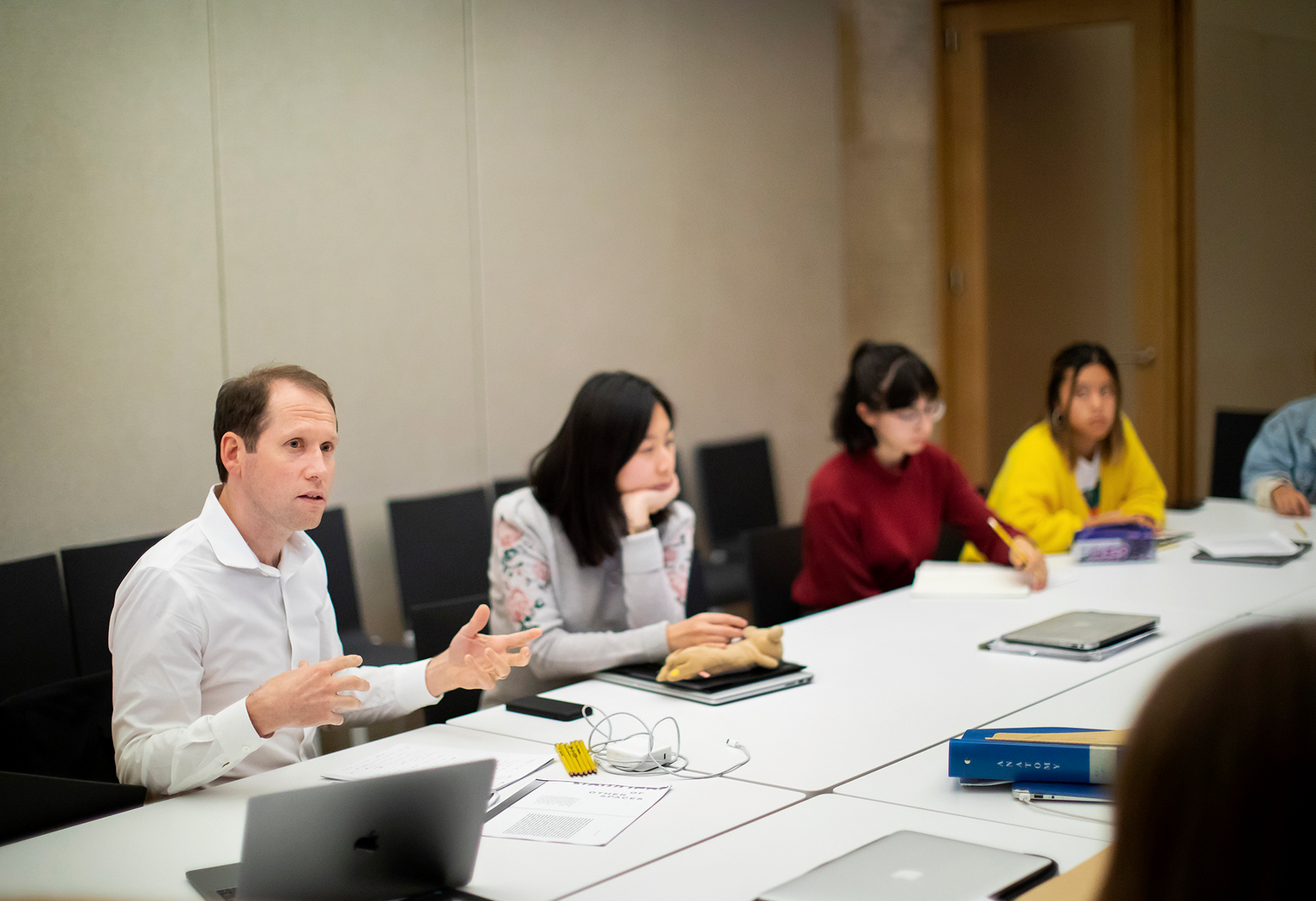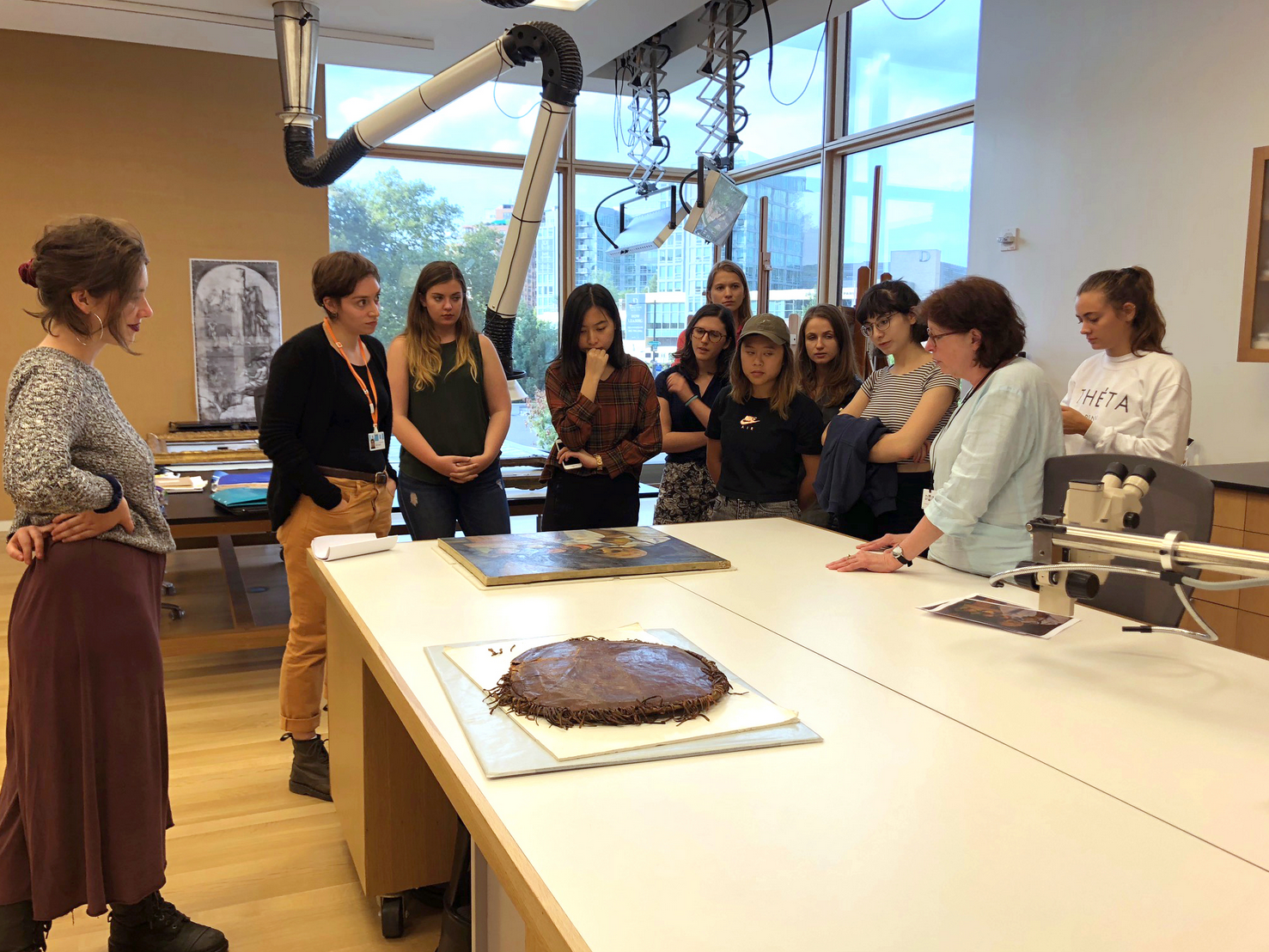
The Barnes Foundation Executive Director and President Thom Collins, pictured in black, leads the students in discussion. Photo by Eric Sucar
November 30, 2018
Brandon Baker / November 27, 2018 / Penn Today
In the second floor of the Barnes Foundation, Penn students engage with Executive Director and President Thom Collins—in the flesh, in a space just footsteps from the galleries that have long dazzled Philadelphians viewing the historic and varied collection of educator and Penn Medical School alum Albert Coombs Barnes. Peek just around the corner, and one would likely spot a Renoir or Picasso.
For the students, this is their classroom.
“It’s amazing,” says Galena Sardamova, a junior architecture major from Sofia, Bulgaria. “I’d never really been in such an environment—I’d always wondered how museums function, and who is behind the making of an exhibition. Working with such an important figure [like Collins] is very humbling. He gives lectures in class, and it’s great to have him interact with us in that way and to share his knowledge and experience. He always invites us to reach out to him by email, to ask him anything.”
Sardamova is one of 10 students in the Spiegel-Wilks Curatorial Seminar undergraduate course, “Ars moriendi: Life and death in early photography,” designed to introduce students to the history of photography—focusing on the 1800s—while offering them access to the Barnes Foundation’s curatorial, operational, and administrative team. It’s a crash course in curatorial studies while serving as very real context for a diverse assortment of intensive photography readings that often ask students to consider perspectives and visual relationships—the latter a cornerstone of the Barnes’ galleries.
And certainly, teaching a course within the walls of the Barnes fits the bill.
“There’s something qualitatively different about being surrounded by works of art, rather than studying them in a textbook or viewing them on a projected surface,” explains Aaron Levy, senior lecturer in the Departments of English and History of Art in the School of Arts and Sciences, who is team-teaching the course with Collins. Levy teaches the endowed seminar once per year, typically with a partner organization, with the goal of rethinking how art history is taught.
“In addition to weekly readings, we have allocated time each week for the students to spend time with the museum staff and collection, and actively encourage the students to think of the museum as a laboratory for thinking about what it means to write art history in the present,” says Levy. “The Barnes Foundation has become an incredibly welcoming and creative home for us.”
Students are fully immersed in the world of museum curation by way of being tasked with writing five wall texts each, all for an upcoming winter photography exhibit at the museum. Their work is collaboratively edited with the Barnes staff and, ultimately, submitted for 25 percent of their grade—posing the challenge of writing succinct-but-educational texts for a general audience.
The students also experience guest lectures from museum staff and, at the end of semester, will engage Mitchell Schnall, the Perelman School of Medicine’s Eugene P. Pendergrass Professor of Radiology, who will ask the students to consider how medical imaging may influence the future study of photography.
“The idea for this [class] really emerged in dialogue with Thom, as part of a larger effort to build connections that bring the University and the Barnes into dialogue and collaboration, and all in ways that connect to faculty and student life,” explains Levy.
The two met through mutual friend, colleague, and photography scholar Kaja Silverman, the Keith L. and Katherine Sachs Professor of Contemporary Art at Penn, and bonded over their shared passion for art history, which precipitated the idea to do a hybrid course that combined art history and curatorial studies—essentially, Penn and the Barnes.
“It’s a treat,” Collins says of teaching Penn students, explaining that he and other Barnes staff who interact with them—like the head of digital technology, senior conservator, chief curator, etc.—don’t often get the type of outside feedback offered by students. “They’re very smart people, these students, and they’re asking questions people don’t generally ask us. That’s fascinating.”
Collins adds that he’s enjoyed engaging in dialogue that is “formative” rather than “summative.”
“It’s really interesting to have, in real time, feedback that gives me fresh perspective on exactly what people this age, with these backgrounds, want and need,” Collins says. “Institutions are very good at telling people what they want and need without asking them, and this is a good opportunity to ask.”
The material of the exhibition, too, he says, lends itself well to what the students are studying, adding new perspectives to the upcoming exhibit as the students prepare text, especially given their fresh intake of photography’s history.
“It’s fascinating to watch students take photographs from the mid-19th century that have so often been spoken about as decorative or aesthetic, and to recognize in them the legacies of colonialism, or changes in new social stratification, in the industrial era,” Collins says. “It’s amazing what they’re pulling out of this stuff.”
Sardamova notes that it was initially challenging to think about how to frame photographs in a way that considers audience and history, but she has since learned to prioritize information, consider perception, and value the collaborative process of wall-text writing.
She’s also just had a lot of fun.
“Every week, when I go to this course, I’m excited about it. This is something that I think is good to have, for a student who is overwhelmed and tired,” she explains. “I’ve been looking forward every week to going to the Barnes and spending time with a group of other students and
Professor Levy, who are all as passionate about the material as I am. Each of them is so knowledgeable and intelligent. It’s been a humbling but also very amazing experience.
“It doesn’t feel like something you can experience every semester,” she says. “Every meeting feels special.”
Click HERE for the article.



